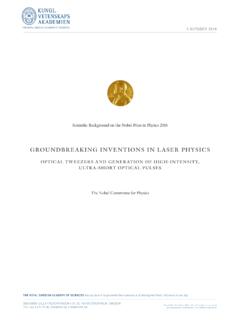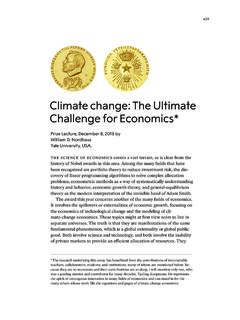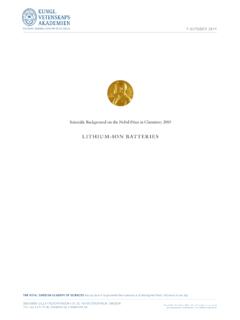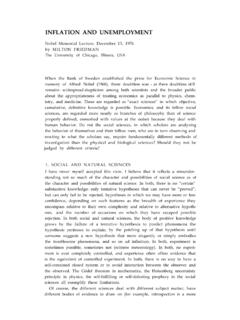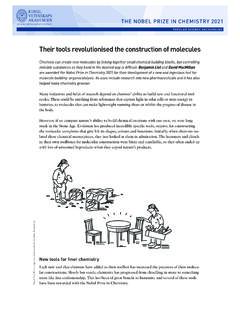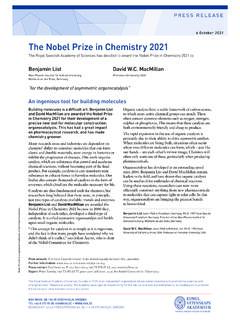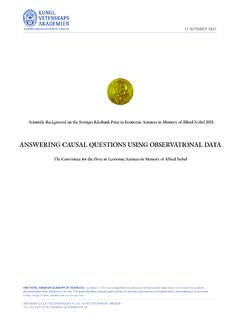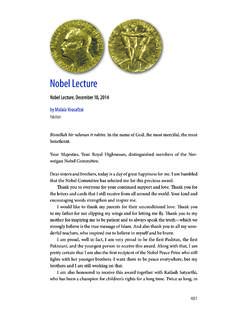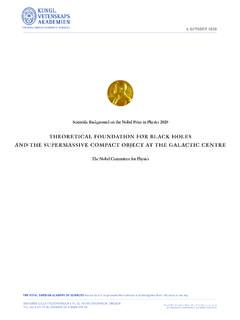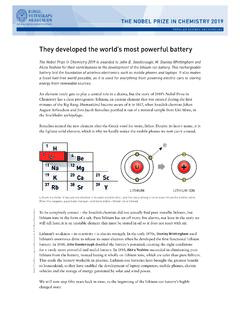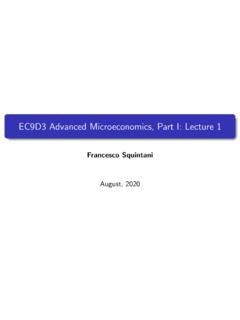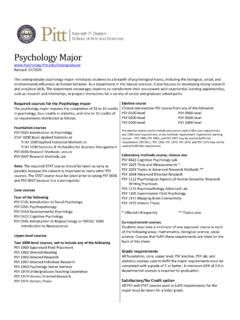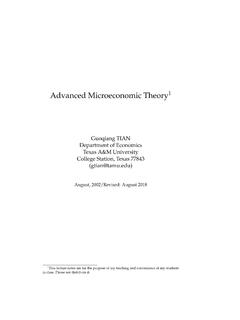Transcription of UNDERSTANDING DEVELOPMENT AND POVERTY ALLEVIATION
1 14 OCTOBER 2019 Scientific Background on the Sveriges Riksbank Prize in Economic Sciences in Memory of Alfred Nobel 2019 UNDERSTANDING DEVELOPMENT AND POVERTY ALLEVIATIONThe Committee for the Prize in Economic Sciences in Memory of Alfred NobelTHE ROYAL SWEDISH ACADEMY OF SCIENCES, founded in 1739, is an independent organisation whose overall objective is to promote the sciences and strengthen their influence in society. The Academy takes special responsibility for the natural sciences and mathematics, but endeavours to promote the exchange of ideas between various 50005 (LILLA FRESCATIV GEN 4 A), SE-104 05 STOCKHOLM, SWEDEN TEL +46 8 673 95 00, Scientific Background on the Sveriges Riksbank Prize in Economic Sciences in Memory of Alfred Nobel 2019 UNDERSTANDING DEVELOPMENT and POVERTY ALLEVIATION The Committee for the Prize in Economic Sciences in Memory of Alfred Nobel October 14, 2019 2 Despite massive progress in the past few decades, global POVERTY in all its different dimensions remains a broad and entrenched problem.
2 For example, today, more than 700 million people subsist on extremely low incomes. Every year, five million children under five die of diseases that often could have been prevented or treated by a handful of proven interventions. Today, a large majority of children in low- and middle-income countries attend primary school, but many of them leave school lacking proficiency in reading, writing and mathematics. How to effectively reduce global POVERTY remains one of humankind s most pressing questions. It is also one of the biggest questions facing the discipline of economics since its very inception. So how best to identify strategies to help the least well-off? This year s Prize in Economic Sciences rewards the experimental approach that has transformed DEVELOPMENT economics, a field that studies the causes of global POVERTY and how best to combat it.
3 In just two decades, the pioneering work by this year s Laureates has turned DEVELOPMENT economics the field that studies what causes global POVERTY and how best to combat it into a blossoming, largely experimental field. Innovations both inside and outside of this field helped sow the seeds of the transformation. Inside the field, 2015 Laureate Angus Deaton pushed the research in DEVELOPMENT economics towards microeconomic analysis. He also championed the idea that the measurement of well-being, especially the well-being of the poor, must be closely integrated into the fight against POVERTY . Outside the field, the so-called credibility revolution, which first took off within labor economics in the early 1990s, pushed economic research in several areas towards a stronger focus on estimating causal effects.
4 In addition, a well-articulated microeconomic theory appeared on how incentives and information, together with behavioral constraints, shape human behavior. This theory rewarded with several Economics Prizes gave researchers a powerful analytical tool kit to analyze the determinants of POVERTY and channels of POVERTY ALLEVIATION . These methodological gains were prerequisites for the transformation to follow, but a core piece of the puzzle was still missing. Specifically, a well-articulated theory may be crucial to discovering possible mechanisms behind POVERTY and to guiding the search for effective ways to combat it. But it is not sufficient to guide policy. While theory can pinpoint certain incentives, it 3 does not tell us how powerful these are in practice. To give just a few examples, theory cannot tell us whether temporarily employing additional contract teachers with a possibility of re-employment is a more cost-effective way to raise the quality of education than reducing class sizes.
5 Neither can it tell us whether microfinance programs effectively boost entrepreneurship among the poor. Nor does it reveal the extent to which subsidized health-care products will raise poor people s investment in their own health. Knowing the right quantitative answers to such specific questions is vital for enhancing human capital, increasing income, and improving health among the poor. Answering these questions requires an empirical approach that allows researchers to draw firm conclusions about causal effects. By pioneering an approach to empirical research for providing such answers, the 2019 Laureates Abhijit Banerjee, Esther Duflo and Michael Kremer have transformed DEVELOPMENT economics. Their approach remained guided by microeconomic theory and the use of microeconomic data.
6 But it shifted focus towards identifying workable policies, for which one can make causal claims of impact. As a result, we now have a large number of concrete results on specific mechanisms behind POVERTY and specific interventions to alleviate it. For example, on schooling, strong evidence now shows that the employment of contract teachers is generally a cost-effective way to improve student learning, while the impact of reduced class size is mixed, at best. On health, poor people s investment in preventive care has been shown to be very sensitive to the prices of health products or services, giving a strong argument for generous subsidies to such investments. On credit, growing evidence indicates that microfinance programs do not have the DEVELOPMENT effects that many had thought when these programs were introduced on a large scale.
7 The transformation of the field involved important contributions by several scholars. Three contributions by the Laureates, however, stand out. First, in the mid-1990s, Kremer and his co-authors launched a set of randomized controlled trials on schooling in In effect, their approach amounted to splitting 1 A randomized controlled trial is a method to estimate the causal impact of a certain intervention, program or policy. A field experiment is a randomized controlled trial in which participants make choices in their normal day-to-day environment. Section 1 gives a more detailed description. 4 up the question of how to boost human capital in low-income countries into smaller and more manageable specific topics, each of which could be rigorously studied via a carefully designed field experiment.
8 Soon thereafter, Banerjee and Duflo, often together with Kremer or others, broadened the set of educational topics and expanded the scope of the research to other areas, including health, credit and agriculture. Second, in a series of contributions, Banerjee and Duflo articulated how pieces from such microeconomic studies can help us get closer to solving the broad DEVELOPMENT puzzle: what explains the enormous difference in per-capita income across countries? They started by documenting a striking empirical fact: low- and middle-income economies encompass enormous heterogeneities in the rates of return to the same factors of production within countries, which dwarf observed cross-country heterogeneities in economy-wide (average) returns. In other words, some firms and individuals in developing countries use the latest technology, while others in the same country and sector use outdated production methods.
9 In high-income countries, these within-sector differences in productivity are much smaller. A deeper UNDERSTANDING of the DEVELOPMENT problem thus requires an explanation of why some firms and individuals do not take advantage of the best available opportunities and technologies. Banerjee and Duflo further argued that these misallocations can be traced back to various market imperfections and government failures. Hence, a core step in UNDERSTANDING , and ultimately alleviating, POVERTY is to identify sources of the observed inefficiencies as well as policies that could address them. Finally, by designing new experimental research methods and by addressing the key challenge of generalizing results from a specific experiment , the issue of external validity the Laureates firmly established this transformed approach to DEVELOPMENT economics.
10 This laid a solid stepping stone for a new generation of researchers in DEVELOPMENT economics and other fields. In sum, by bringing the theory of incentives closer to direct applicability, the research by the Laureates has profoundly altered the practice of DEVELOPMENT economics. The work by the Laureates, and by many other scholars who followed in their footsteps, has dramatically increased the practical quantitative knowledge necessary to isolate key mechanisms behind POVERTY and behavioral responses to various policy 5 interventions. This work has significantly deepened our UNDERSTANDING of POVERTY in the developing world. We start this overview by describing the core ideas behind the new microeconomic approach to DEVELOPMENT economics and by discussing the key foundational contributions (Section 1).
